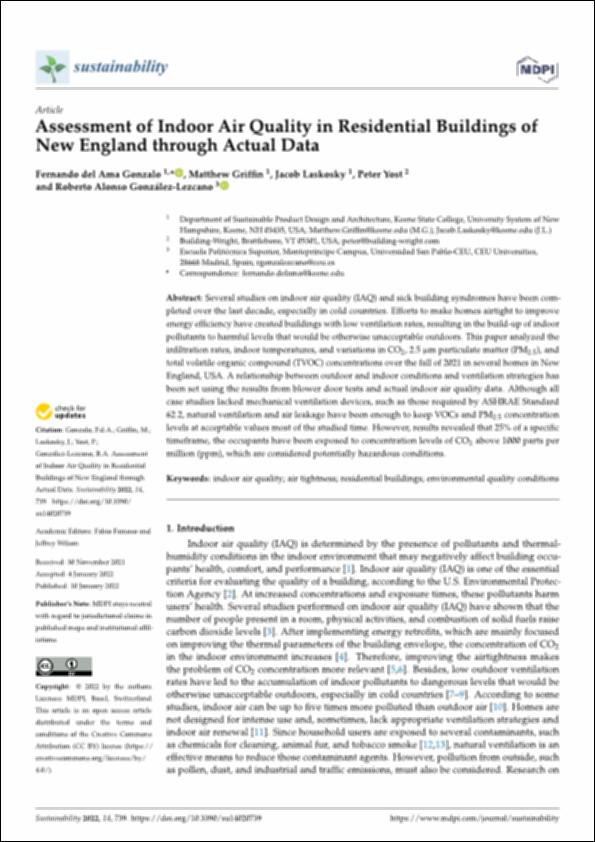Por favor, use este identificador para citar o enlazar este ítem:
http://hdl.handle.net/10637/14542Assessment of Indoor Air Quality in Residential Buildings of New England through Actual Data
| Título : | Assessment of Indoor Air Quality in Residential Buildings of New England through Actual Data |
| Autor : | Del Ama Gonzalo, Fernando Griffin, Mathew Laskosky, Jacob Yost, Peter González Lezcano, Roberto Alonso. |
| Materias: | Indoor air quality; Air tightness; Residential buildings; Environmental quality conditions |
| Editorial : | MDPI |
| Citación : | Gonzalo, F.d.A.; Griffin, M.; Laskosky, J.; Yost, P.; González-Lezcano, R.A. Assessment of Indoor Air Quality in Residential Buildings of New England through Actual Data. Sustainability 2022, 14, 739. https://doi.org/10.3390/ su14020739 |
| Resumen : | Several studies on indoor air quality (IAQ) and sick building syndromes have been completed over the last decade, especially in cold countries. Efforts to make homes airtight to improve energy efficiency have created buildings with low ventilation rates, resulting in the build-up of indoor pollutants to harmful levels that would be otherwise unacceptable outdoors. This paper analyzed the infiltration rates, indoor temperatures, and variations in CO2, 2.5 m particulate matter (PM2.5), and total volatile organic compound (TVOC) concentrations over the fall of 2021 in several homes in New England, USA. A relationship between outdoor and indoor conditions and ventilation strategies has been set using the results from blower door tests and actual indoor air quality data. Although all case studies lacked mechanical ventilation devices, such as those required by ASHRAE Standard 62.2, natural ventilation and air leakage have been enough to keep VOCs and PM2.5 concentration levels at acceptable values most of the studied time. However, results revealed that 25% of a specific timeframe, the occupants have been exposed to concentration levels of CO2 above 1000 parts per million (ppm), which are considered potentially hazardous conditions. |
| URI : | http://hdl.handle.net/10637/14542 |
| Derechos: | http://creativecommons.org/licenses/by-nc-nd/4.0/deed.es openAccess |
| Fecha de publicación : | 10-ene-2022 |
| Centro : | Universidad San Pablo-CEU |
| Aparece en las colecciones: | Escuela de Politécnica Superior |
Los ítems de DSpace están protegidos por copyright, con todos los derechos reservados, a menos que se indique lo contrario.


